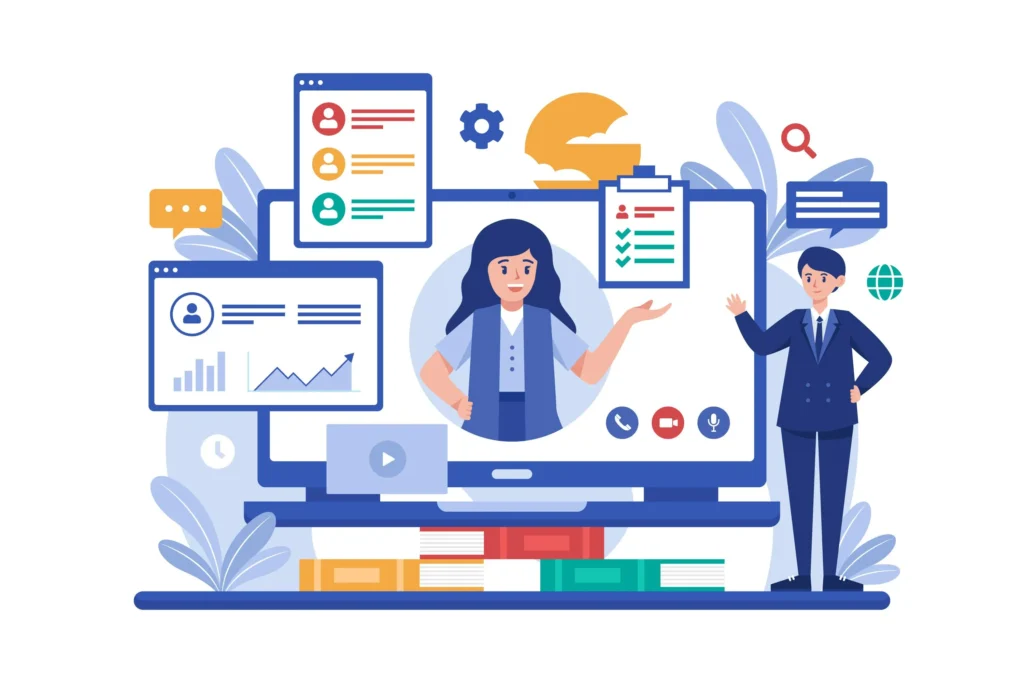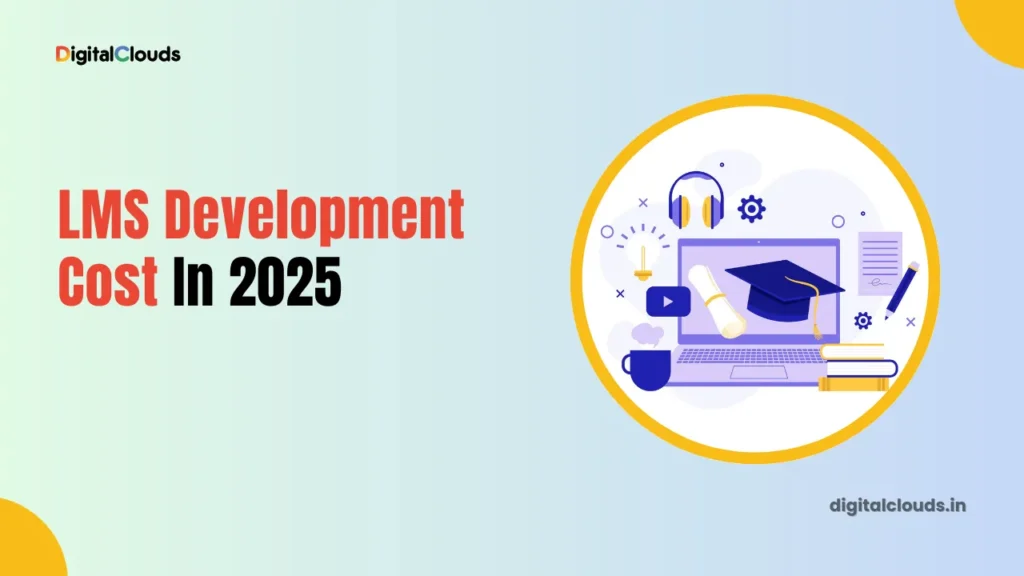Creating a high-quality online learning platform is now essential for educational institutions, corporate training, and individual educators. Before you begin, it’s important to understand the true LMS Development Cost so you can budget accurately and avoid hidden expenses in the future.
Whether you’re an instructor aiming to expand your reach, a business looking to upskill your workforce, or an entrepreneur planning to launch a large-scale e-learning marketplace, understanding the real Learning Management System Website Development costs is a crucial first step. These expenses extend far beyond basic design and development — they also include features such as course management systems, progress tracking, secure payment gateways, mobile-friendly design, advanced reporting and analytics, gamification elements, ongoing maintenance, and regular updates.
In this blog post, we’ll explore all the key components that impact the LMS Website Development Cost in 2025. By the end, you’ll gain a full picture of what it takes to build a successful LMS platform and learn how to allocate your budget effectively for long-term success. Let’s get started!
What is an LMS?

A Learning Management System (LMS) is a specialized software platform designed to facilitate the delivery, management, tracking, and assessment of educational or training programs. It serves as a centralized hub where instructors can create and share content, and learners can access courses and engage with learning materials from anywhere at any time.
An LMS allows educational institutions, businesses, and training providers to move beyond traditional classrooms and bring learning online in a structured, scalable, and engaging way. It supports various formats, including videos, quizzes, reading materials, and interactive assignments, giving learners a comprehensive educational experience.
What Are The Types of LMS?
When planning to invest in LMS development, understanding the different types of LMS is essential to make an informed decision and accurately estimate LMS Development cost. Each type serves specific needs and impacts your budget differently.
- Cloud-based LMS (SaaS): Hosted by a third-party provider and accessed online. Easy to set up, scalable, and requires minimal IT maintenance.
- Self-hosted LMS: Installed and maintained on your own servers, offering greater customization and control over data security and features.
- Open-source LMS: Free to use and customize, examples include Moodle and Open edX. Suitable for organizations with technical expertise to manage and extend functionality.
- Commercial LMS: Paid systems that come with vendor support, advanced features, and ready-made integrations. Great for enterprises and institutions needing reliability.
- Academic LMS: Tailored for schools, colleges, and universities. Focuses on course management, student assessments, grading systems, and class collaboration tools.
- Corporate LMS: Used in businesses for onboarding, compliance, skill development, and employee certifications. Often includes performance tracking and integrations with HR systems.
- Mobile LMS: Designed specifically for mobile devices, enabling on-the-go learning and microlearning modules.
- Integrated LMS: Combines with other enterprise systems, such as ERP or CRM, to provide a seamless experience for both learners and administrators.
- Custom LMS: Fully customized to meet unique organizational requirements, ideal for specialized training needs.
- Community or social LMS: Focused on collaborative learning with strong social features such as discussion boards, peer feedback, and group activities.
Understanding these types allows you to select an LMS that fits your technical capabilities, budget, learning objectives, and user preferences. Choosing the right one will maximize your investment and improve learner engagement and outcomes.
What is the Purpose of LMS Development?
The purpose of LMS development is to create a centralized, efficient, and engaging online platform where organizations can deliver training, manage learners, and track educational outcomes effectively. Understanding LMS Development cost is important at this stage, as it allows you to plan resources for key features and functionalities that align with your objectives.
- Streamline training processes: Automate administrative tasks such as enrollments, reminders, grading, and certification, reducing manual workload.
- Enhance learner engagement: Use multimedia content, gamification, quizzes, and discussion forums to keep learners interested and motivated.
- Enable remote and flexible learning: Allow learners to access training materials anytime, anywhere, on any device, empowering them to learn at their own pace.
- Centralize content and data: Keep all learning materials, assessments, and learner records in one secure, easy-to-access location.
- Provide personalized experiences: Adapt learning paths based on individual progress, preferences, or performance, making learning more effective.
- Improve tracking and reporting: Detailed analytics provide insights into learner progress, course effectiveness, and skill gaps, enabling continuous improvement.
- Reduce training costs: Cut expenses associated with classroom rentals, printed materials, travel, and instructor fees.
- Support compliance and certification: Ensure that employees or students meet regulatory training requirements and automatically manage recertification processes.
- Promote lifelong learning: Encourage continuous development through modular, on-demand learning options that keep up with evolving skills and industry trends.
- Boost organizational efficiency: A professional LMS website demonstrates your commitment to high-quality training, enhancing brand credibility and reputation.
Ultimately, LMS development empowers organizations to deliver impactful, scalable, and accessible learning experiences that meet modern learners’ expectations and business objectives.
- Also Read: How Much Does Ecommerce Development Cost
Who Can Benefit from Building a Learning Management System?
A wide range of organizations and individuals can benefit from building a Learning Management System. With its versatile applications, an LMS can support different learning goals, audiences, and operational models.
- Educational institutions: Schools, universities, and online colleges can use an LMS to manage courses, deliver lectures, conduct assessments, and support remote or hybrid learning.
- Corporations and enterprises: Businesses use LMS platforms for employee onboarding, skill development, compliance training, and leadership programs.
- Non-profit organizations: NGOs can educate their teams, volunteers, and communities, while also running awareness and capacity-building programs.
- Healthcare organizations: Hospitals and clinics can train medical staff on the latest technologies, protocols, and compliance standards efficiently.
- Government agencies: Public sector organizations benefit from streamlined, consistent training programs for employees, ensuring standardized service delivery and policy compliance.
- Professional training institutes: Vocational and skill development centers can reach a broader audience and monetize courses through an LMS.
- Franchises and retail chains: Standardized training across multiple locations ensures consistent service quality and brand adherence.
- Freelancers and coaches: Independent educators can package expertise into online courses, grow their audience globally, and create new revenue streams.
- Customer education: Companies can use LMS platforms to help customers learn how to use their products, reducing support tickets and increasing customer satisfaction.
- Industry associations and certification bodies: Offer continuing education, certification programs, and skill development to members.
- Technology providers: Tech firms can create training for partners, resellers, or clients to ensure proper product use and maintain standards.
Whether for internal training, academic instruction, or commercial course sales, an LMS helps streamline processes, expand reach, and deliver measurable results. Any organization or individual looking to modernize and improve their learning experience stands to gain significantly.
What to Consider When Creating an LMS Website?
Developing a Learning Management System involves a series of strategic decisions that impact the final product’s performance, usability, and long-term success. Whether you’re a school, university, corporate training provider, or a course seller, understanding the key considerations during the development process is critical to controlling your LMS Development cost and building a future-ready platform.
Here’s what you need to consider:
- Define your goals: Clearly identify the purpose of your LMS — is it for internal employee training, academic use, customer education, or commercial online courses?
- Understand your target audience: Consider the learners’ age, technical skills, preferred learning styles, and accessibility needs. This influences design, features, and content delivery.
- Content strategy: Plan the type of content you’ll deliver (videos, presentations, quizzes, live webinars) and how it will be structured.
- Choose the right tech stack: Select technologies that are scalable, secure, and capable of supporting your long-term growth.
- User experience (UX) design: The interface should be intuitive and easy to navigate, minimizing the learning curve for new users.
- Mobile-friendliness: Many learners prefer accessing courses on smartphones and tablets, so mobile optimization is crucial.
- Integration needs: Consider integrations with video conferencing tools, HR systems, payment gateways, CRMs, and analytics platforms.
- Assessment and certification: Build robust testing tools, assignment submissions, and automatic certification options to validate learning outcomes.
- Security and data privacy: Implement strong security measures like data encryption, multi-factor authentication, and GDPR compliance to protect user data.
- Scalability and performance: Ensure your system can handle increasing numbers of users and large volumes of content without slowdowns.
- Multilingual support: If you have a diverse audience, offer content in multiple languages to improve reach and accessibility.
- Budget and timeline: Factor in not just initial development costs but also maintenance, content creation, and marketing expenses.
- Support and maintenance planning: Decide how you’ll handle technical support, bug fixes, and feature updates to keep the LMS running smoothly.
Carefully considering these aspects will help you build an LMS website that is not only functional but also engaging, effective, and aligned with your business or educational objectives.
Key Components Required for Successful LMS Development
A successful LMS website is more than just a collection of online courses. It’s a complete ecosystem designed to deliver an effective and engaging learning experience. Here are the essential components you need to include:
- Course management system: Easily create, edit, organize, and manage courses, modules, and lessons.
- User management: Handle student registrations, roles, permissions, and profiles efficiently.
- Content delivery tools: Support for various formats such as video, audio, PDFs, SCORM packages, and live streaming sessions.
- Assessment and evaluation: Built-in quizzes, exams, assignments, and feedback tools to measure learner progress and understanding.
- Certification and tracking: Automatically generate certificates upon course completion and track compliance or recertification requirements.
- Gamification features: Points, badges, leaderboards, and challenges to motivate learners and improve engagement.
- Discussion forums and social learning: Enable peer-to-peer interactions, group discussions, and community building.
- Reporting and analytics: Detailed dashboards to monitor learner performance, engagement rates, course popularity, and other critical KPIs.
- Mobile compatibility: Fully responsive design to ensure seamless learning experiences across all devices.
- Secure payment systems: Integration with payment gateways for paid courses, subscriptions, and one-time purchases.
- Notifications and alerts: Automated emails and in-app notifications to keep learners informed about deadlines, updates, and new content.
- Customizable design: Branding options and flexible templates to match your organization’s identity.
- Integration capabilities: Connect with external systems such as CRMs, HR software, email marketing tools, and video conferencing platforms.
- Accessibility features: Compliance with accessibility standards (like WCAG) to support learners with disabilities.
- Data security and privacy: Strong security measures to protect user data, including encryption and secure login protocols.
By including these critical components, you can create an LMS website that not only delivers content effectively but also keeps learners engaged, ensures smooth management, and supports future growth.
Key Factors Affecting LMS Development Cost in 2025

The cost of developing an LMS website can vary greatly depending on numerous factors. Understanding these key cost drivers will help you plan your budget effectively and avoid unexpected expenses.
- Project scope and complexity: The more complex your LMS (advanced features, large course libraries, integrations), the higher the development cost.
- Customization requirements: Off-the-shelf solutions are more affordable, but custom-designed features and workflows increase costs.
- Design and UX: A well-designed, user-friendly interface often requires more investment in design, prototyping, and user testing.
- Technology stack: The choice of frameworks, programming languages, and third-party tools can impact both upfront and maintenance costs.
- Content development: High-quality video production, animations, interactive quizzes, and downloadable materials add to the overall budget.
- Integration needs: Connecting with CRMs, payment gateways, HR systems, or marketing platforms requires additional development work.
- Security measures: Advanced security features, such as data encryption, secure payment systems, and compliance with global data protection laws, add to the cost.
- Mobile optimization: Designing for cross-device compatibility may involve additional design and testing time.
- Multilingual support: Implementing multiple language options and localization increases content creation and development expenses.
- Scalability requirements: Building an LMS that can handle future growth and large user bases will require a stronger infrastructure, impacting costs.
- Hosting and server costs: Depending on whether you choose self-hosting or cloud-based solutions, infrastructure expenses can vary significantly.
- Ongoing maintenance and support: Consider post-launch updates, bug fixes, and technical support as part of your total investment.
- Regulatory compliance: Meeting industry-specific standards or accessibility guidelines might require specialized development work.
By understanding these factors, you can make informed decisions about where to allocate your budget, prioritize essential features, and plan for long-term sustainability.
How Much Does LMS Development Cost in 2025?
The LMS Development Cost in 2025 can vary widely based on your requirements, the complexity of features, and the team you hire. On average, you can expect to pay anywhere from $10,000 to $150,000 or more depending on scope.
A basic LMS website with essential features like course creation, basic assessments, and user management might cost around $10,000 to $25,000. This option is typically ideal for small educational institutions or small businesses that need a straightforward solution without extensive customization.
For a more advanced LMS with features such as gamification, advanced analytics, custom branding, mobile app support, and integrations with CRMs or HR systems, the cost can range from $40,000 to $80,000. This range often suits mid-sized organizations or training companies that require a more comprehensive, engaging learning experience.
When it comes to large enterprises, universities, or businesses with unique and highly customized needs, the cost can easily reach $100,000 to $150,000 or more. Such LMS platforms include features like AI-based recommendations, advanced automation, multi-language support, complex certification workflows, and high-level data security measures.
Several factors contribute to the LMS Development costs:
- Number of features and level of customization
- Design complexity and branding needs
- Integration requirements with other software
- Content creation (videos, quizzes, interactive modules)
- Hosting and server infrastructure
- Ongoing maintenance and support plans
It’s crucial to look beyond the initial development cost and also plan for ongoing expenses, including updates, new feature rollouts, security patches, and technical support. Investing in a robust LMS today ensures you have a scalable, future-proof platform that supports your educational or training goals in the long run.
Breakdown of Typical LMS Development Cost Ranges in 2025
Understanding a detailed cost breakdown can help you plan your LMS website budget more effectively and avoid unexpected expenses. In 2025, LMS development costs generally fall into the following tiers:
| Tier | Estimated Cost Range | Key Features & Inclusions |
| Basic LMS | $10,000 – $25,000 | Best for small organizations and startups needing a simple online learning platform. Includes essential course creation, basic quizzes, user management, limited customization, and minimal reporting. No advanced integrations, making it quick and budget-friendly to launch. |
| Mid-range LMS | $40,000 – $80,000 | Ideal for growing businesses and educational institutions that need more interactivity and branding. Offers advanced course structures, gamification, mobile-friendly design, detailed analytics, social learning tools, and CRM/HR system integrations. Balances strong features with reasonable cost. |
| High-end LMS | $100,000 – $150,000+ | Suited for enterprises, universities, and large training providers needing full customization and scalability. Includes AI-driven learning paths, deep integrations with enterprise systems, multi-language support, advanced automation, robust security, and compliance. Handles thousands of users with high performance. |
How Much Does LMS Website Maintenance Cost?
Building an LMS website is only the beginning; maintaining it properly is crucial for long-term success. LMS website maintenance ensures that your platform remains secure, functional, and engaging for users. In 2025, maintenance costs can vary widely, usually ranging from $500 to $5,000 per month, depending on the complexity and scale of the LMS.
- Security updates are a major part of maintenance. With data privacy laws becoming stricter and cyber threats evolving rapidly, your LMS must have regular security patches, vulnerability assessments, and compliance checks to protect sensitive learner data.
- Bug fixes and performance optimization are ongoing needs. As you add new features or update content, unexpected bugs can arise. Maintaining high site speed and smooth functionality keeps users engaged and prevents frustration.
- Content updates are also part of maintenance. Updating or adding new courses, quizzes, resources, or media ensures your LMS stays current and relevant to learners.
- Technical support and user assistance should be factored in. Whether it’s helping instructors upload content, assisting students with login issues, or fixing integration glitches, dedicated support is vital.
- Feature upgrades and scalability improvements are often needed as your user base grows. You may want to integrate new tools, improve reporting dashboards, or implement advanced AI-powered personalization features.
- Hosting and server management costs are another component, especially if you run a high-traffic LMS or require enterprise-grade infrastructure with advanced backup and disaster recovery capabilities.
Additionally, consider license renewals and third-party plugin or API costs, which can fluctuate yearly.
Regular maintenance not only prevents costly downtime but also demonstrates to your learners and stakeholders that you’re committed to delivering a reliable, modern, and top-quality learning experience. Investing in proper maintenance is just as important as the initial development — it ensures your LMS remains competitive and future-ready.
How to Design Your LMS Website
Designing your LMS website effectively is crucial to creating a seamless, engaging, and user-friendly learning experience. Here are key points to consider when designing your LMS website:
- Start with a user-centered approach: Understand your learners’ needs and preferences to create an intuitive, engaging, and effective design that suits all user types.
- Ensure intuitive navigation: Build clear menus, logical course structures, and easy-to-follow paths so users can find what they need without confusion.
- Use responsive design: Make sure your LMS looks and functions flawlessly on all devices, including desktops, tablets, and smartphones, supporting learning anywhere, anytime.
- Incorporate strong branding: Include your logo, brand colors, and consistent visual elements to create a professional identity and build trust with learners.
- Create a clear visual hierarchy: Use contrasting colors, bold fonts, and well-placed buttons to guide learners’ attention to key actions like starting a course or submitting a quiz.
- Focus on accessibility: Design for all users by using high-contrast colors, alt text for images, and making sure the site works with screen readers and keyboard navigation.
- Include engaging multimedia: Add images, videos, infographics, and animations to make courses more interactive, support different learning styles, and increase knowledge retention.
- Implement interactive elements: Integrate quizzes, gamified progress bars, badges, and polls to make learning fun and motivate users to continue engaging with the content.
- Personalize the user experience: Create dashboards that show individual progress, recommended courses, and certificates to make each learner feel valued and supported.
- Provide clear feedback mechanisms: Add surveys, course ratings, and feedback forms so learners can share their thoughts, helping you improve content and user experience.
- Test before launch: Conduct thorough usability testing with real users to identify design issues, gather feedback, and make necessary refinements for a smoother launch.
By focusing on these points, you ensure your LMS website not only looks appealing but also delivers a highly effective, enjoyable, and accessible learning experience.
Should You Hire an LMS Development Company?
When building an LMS, one of the biggest decisions is whether to handle development internally or hire a professional LMS website development company. While developing in-house can seem cost-effective at first, it often involves unexpected challenges.
Hiring a specialized LMS development company offers many advantages:
- Expertise and experience: A dedicated company brings years of experience in designing, developing, and launching LMS platforms. They understand industry best practices and emerging trends, helping you avoid common pitfalls.
- Comprehensive services: From UX design and course structuring to integrations and security implementation, a professional agency can handle every aspect of your project.
- Time efficiency: Developing an LMS in-house can take months or even years. An experienced team can accelerate your timeline without compromising quality.
- Access to a multidisciplinary team: When you hire a company, you get designers, developers, QA testers, project managers, and business analysts — all working together to deliver a polished product.
- Post-launch support: Reliable agencies provide ongoing support, updates, and maintenance services, ensuring your LMS stays up-to-date and bug-free.
- Scalability: A professional company builds your LMS with future growth in mind, so you won’t face major rebuilds as your user base expands.
- Quality assurance: Agencies have robust testing processes to catch issues early and deliver a seamless user experience.
- Security and compliance: Data privacy and protection are critical in e-learning. LMS development companies have experience implementing advanced security measures and ensuring legal compliance (GDPR, FERPA, etc.).
While hiring a professional company does involve a higher upfront cost, it often saves money long-term by avoiding rework, security breaches, and poor user adoption.
In summary, if you want a high-quality, scalable, and feature-rich LMS that provides an exceptional learning experience and meets business objectives, partnering with an experienced LMS development company is often the smartest choice.
How Often Should You Update Your LMS Website?
Regular updates are essential to keep your LMS website secure, engaging, and up to date with modern technology standards. Here are the key points explaining how often and why you should update your LMS website:
- Apply security updates immediately: Cyber threats evolve constantly. As soon as new security patches or vulnerability fixes are released, they should be applied right away to protect learner data and maintain trust.
- Update content regularly: Courses, modules, and learning materials should be refreshed periodically. Outdated content can reduce engagement and make your platform appear irrelevant. Add new lessons, update quizzes, and include new resources to keep learners interested.
- Enhance features periodically: Introducing new features or improving existing ones keeps your LMS competitive. Consider adding gamification elements, social learning tools, or AI-driven course recommendations every few months.
- Perform design and UX improvements at least once a year: User preferences and design trends change. Evaluate your design annually to improve usability, update visual elements, and make the learning experience more enjoyable.
- Review integrations and compatibility quarterly: Your LMS may integrate with payment gateways, CRMs, or HR systems. These integrations should be checked every 3–6 months to ensure they remain functional and secure.
- Optimize for performance regularly: Slow load times and technical glitches frustrate users. Optimize website speed, fix bugs, and improve mobile responsiveness on a routine basis, ideally every quarter.
- Ensure compliance updates as needed: Laws and accessibility standards (like GDPR and WCAG) change over time. Check for compliance updates at least once a year and implement necessary adjustments.
- Collect and implement user feedback continuously: Encourage learners and instructors to share feedback. Use this information to make small, ongoing updates that improve overall satisfaction.
Updating your LMS consistently ensures you deliver a reliable, engaging, and modern learning experience, ultimately supporting higher retention rates and improved learning outcomes.
Ultimate Tips to Reduce LMS Development Costs in 2025
Building an LMS in 2025 is an exciting opportunity to deliver modern, engaging learning experiences, but if you’re not strategic, LMS Development Costs can quickly spiral out of control. Here’s how to manage your budget wisely and still achieve a high-quality outcome:
- Set clear goals and priorities upfront: Define your platform’s main objectives and essential features early to avoid costly revisions and unexpected Development Costs later.
- Start with an MVP (Minimum Viable Product): Focus on delivering core, must-have functionalities first. You can add more complex features in phases, keeping initial investments lower and validating user demand early.
- Use pre-built themes and frameworks: Choose ready-made design templates and feature frameworks to save significant time and money while still creating a modern, professional LMS.
- Leverage open-source LMS platforms: Starting with open-source solutions like Moodle or Open edX reduces licensing expenses, allowing you to focus your budget on customization and branding.
- Opt for cloud-based hosting: Cloud hosting eliminates the need for heavy infrastructure investment and reduces long-term maintenance costs, providing more flexibility as your user base grows.
- Limit initial third-party integrations: Only connect critical systems like payment gateways or CRMs at launch; additional integrations can be added later when your budget permits.
- Hire an experienced LMS development team: A skilled team ensures higher quality, fewer errors, and faster delivery — preventing unexpected increases in Development Costs due to rework or poor implementation.
- Automate repetitive admin tasks: Automation in enrollment, progress tracking, and reporting saves time and reduces operational overhead in the long run.
- Roll out features in phases: Gradually release new modules and advanced functionalities, spreading your costs over time and allowing space for continuous improvement.
- Train your internal team early: Proper training empowers your staff to manage the LMS efficiently and minimizes reliance on external support, reducing ongoing costs.
By following these smart tips, you can significantly lower LMS Development Costs in 2025 while still creating a powerful, scalable, and learner-friendly platform.
Why Choose DigitalClouds for LMS Development?
At DigitalClouds, we build websites that are not only visually appealing but also designed to grow your brand and boost your business online. Whether you need a business website, an ecommerce platform, or a custom LMS, our expert team delivers secure, user-friendly, and high-performing solutions tailored to your goals.
We also provide digital marketing services to help you reach your target audience and increase your online presence effectively.
With DigitalClouds, you can:
- Get a fully customized and responsive website that works smoothly across all devices.
- Integrate advanced features like booking systems, payment gateways, or LMS tools.
- Enhance your SEO and attract more customers.
- Scale your website easily as your business grows.
Ready to transform your online presence? Please explore our web development services and get started with DigitalClouds today.
FAQs About LMS Website Development Costs in 2025
Find clear, detailed answers to the most common questions about LMS website development costs in 2025, helping you understand what to expect, plan your budget wisely, and make confident decisions.
What is the average LMS Development Cost in 2025?
The average LMS Development Cost in 2025 ranges between $25,000 and $150,000 or more, depending on project size, customization needs, and included features. A basic system with essential learning modules and simple course management tools will be at the lower end. Meanwhile, a fully custom LMS with gamification, mobile compatibility, advanced analytics, and integrations (such as with HR or CRM systems) will be more expensive. Investing in a high-quality LMS supports better learner engagement, streamlines training processes, and can significantly improve organizational learning outcomes, making it a strong long-term investment for educational institutions and businesses alike.
What key features increase LMS Development Cost the most?
Features that raise the cost the most include advanced reporting and analytics, gamification modules, multi-language support, video conferencing integration, AI-driven adaptive learning, and mobile apps. Additional customizations like branded dashboards, certification paths, and integrations with third-party tools (like Zoom or Salesforce) also increase costs. While these functionalities add value, it’s crucial to prioritize what your learners truly need to balance budget and effectiveness. Identifying must-have features early can help you avoid unexpected expenses and ensure that you deliver a platform that meets both learner and organizational goals efficiently.
Can I reduce LMS Development costs by using open-source platforms?
Yes, using open-source platforms like Moodle can lower your initial LMS Website Development Cost since the core software is free. However, customization, design, maintenance, and hosting expenses still apply. While this route saves money upfront, it requires technical expertise to modify and maintain, which can incur hidden costs over time. For organizations with limited budgets, open-source can be a great starting point, but it’s important to budget for long-term support and enhancements. Weighing the trade-offs carefully ensures that you maintain control over the system’s quality and scalability while keeping expenses reasonable.
How long does it take to develop a custom LMS Website?
Developing a custom LMS website usually takes 4 to 9 months, depending on complexity and feature set. While a longer timeline can increase LMS website development Cost, it ensures thorough planning, testing, and implementation. Custom LMS projects often require detailed requirement analysis, UI/UX design, content development, integration of third-party tools, and multiple testing phases to ensure performance and security. Rushing the process can lead to technical debt and a poor user experience. Taking the time to do it right results in a more stable, scalable, and user-friendly platform that supports learners effectively.
Does integrating advanced analytics increase LMS Development Cost?
Yes, adding advanced analytics capabilities significantly raises LMS Development prices. These analytics help track learner progress, identify engagement trends, and measure the effectiveness of courses. While the upfront cost is higher, these insights can drive better decision-making and improve learning outcomes. Organizations benefit from tailored data dashboards that allow administrators to optimize content and learner paths. Investing in analytics makes your LMS more valuable, as it supports evidence-based improvements and demonstrates ROI to stakeholders. It’s a critical feature for businesses and institutions serious about measuring the impact of their training programs.
Should I budget for ongoing maintenance after development?
Absolutely. Beyond the initial LMS Cost, you should budget 15%–25% annually for ongoing maintenance and updates. This includes security patches, feature enhancements, bug fixes, and content updates. Proper maintenance ensures that your LMS remains secure, functional, and aligned with evolving learner needs. Neglecting maintenance can result in system downtimes, data vulnerabilities, and decreased user satisfaction. A well-maintained LMS keeps your learning ecosystem modern and competitive, helping you retain learners and protect your investment. Many agencies offer maintenance packages to help organizations manage this efficiently without straining internal resources.
Is mobile responsiveness included in LMS Development Cost?
Today, mobile responsiveness is considered essential and is usually included in the base Development Cost. With learners increasingly using smartphones and tablets, a responsive LMS ensures accessibility anywhere, anytime. A mobile-optimized platform improves engagement, reduces bounce rates, and supports flexible learning environments. Confirm with your development partner that mobile design is included in the scope to avoid extra charges later. Investing in responsive design improves learner satisfaction and future-proofs your LMS against evolving technology trends, making it a worthwhile and necessary part of your budget planning.
Can gamification elements impact LMS Development Cost?
Yes, integrating gamification elements like badges, leaderboards, points, and progress tracking increases the Development Cost. These features make learning more interactive and motivate learners to engage consistently. While they raise upfront costs, they improve course completion rates and create a more enjoyable user experience. If you want to foster a learning culture that feels dynamic and rewarding, gamification is a powerful tool worth the investment. Discuss gamification during the planning phase to ensure alignment with your educational goals and to accurately forecast additional design and development resources needed.
Should I hire an agency or build in-house to manage LMS Development costs?
Hiring an experienced agency can optimize your Cost, as they bring specialized expertise, tested workflows, and support services. While in-house development gives more control, it requires significant time, resources, and dedicated technical talent. Agencies can provide end-to-end services, including design, development, testing, and maintenance, ensuring higher quality and faster time-to-market. If you lack internal capacity, an agency often proves more cost-effective in the long run. Carefully evaluating your organization’s capabilities and goals helps determine the most efficient path to building a successful LMS that fits your budget and vision.
How can I lower my LMS Development Cost without compromising quality?
To reduce the Cost without sacrificing quality, start by prioritizing essential features for launch and plan advanced functions as future upgrades. Use open-source solutions as a foundation where possible, and repurpose existing content to save time. Choose a phased development approach (MVP) to validate ideas early and control expenses. Collaborating closely with experienced developers helps you identify cost-saving opportunities while ensuring a robust and scalable platform. Clear communication, realistic timelines, and precise requirements are critical to avoiding scope creep and unexpected expenses while still delivering a high-quality learning experience.






